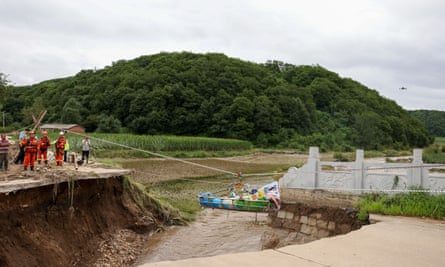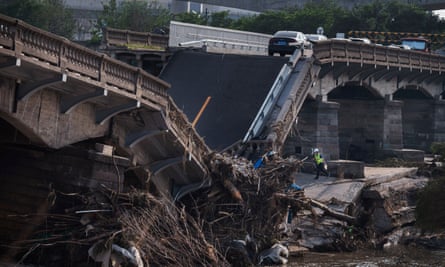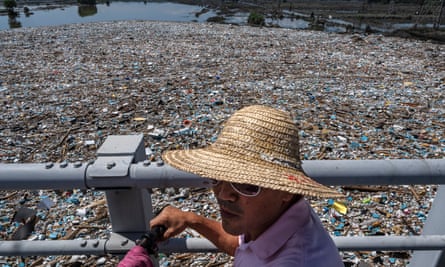At least 14 people are dead after torrential rain hit China’s north-eastern Jilin province, state media has reported, in the latest fatalities from more than a week of weather-related disasters across the country.
Thousands of troops have been sent into affected areas of Jilin and neighbouring Heilongjiang to assist with the flood response, evacuations, distributing supplies and fixing damaged roads. State media outlet Xinhua said about 2,000 soldiers and 5,000 members of the People’s Armed Police paramilitary force had been deployed.
China has been hit with record heavy rains in recent weeks, with Beijing saying on Friday that natural disasters had caused 147 deaths or disappearances last month.
A further 14 deaths and one missing person were reported on Sunday by state-run broadcaster CCTV, citing local authorities, after heavy rain in the north-eastern city of Shulan. Four local officials including a deputy mayor were reported killed, washed away by flood waters while travelling to inspect the area, state media said. Their bodies were recovered on Saturday.

Heavy rains in the area had now “basically ended”, Xinhua said, with almost 19,000 evacuated and 21 “temporary relocation facilities” set up.

Torrential rain brought on in the aftermath of Typhoon Doksuri, which hit mainland China as a typhoon before veering northwards, is the most severe since records began 140 years ago.
Clean-up operations are ongoing after the overwhelming rainfall, which destroyed infrastructure and flooded entire districts.

Authorities have warned that in parts of two major rivers in Heilongjiang and Jilin, water levels “surpassed the alert line”, Xinhua reported.
CCTV broadcast video of recovery efforts in the north-eastern province of Heilongjiang showing villagers using shovels to clear muddy water from buildings.

Millions of people have been hit by extreme weather events and prolonged heatwaves around the globe in recent weeks, events that scientists say are being exacerbated by climate change.
Officials also said on Saturday that at least 10 people had been killed in floods in a city in Hebei province, one of the most affected by the rains, where more than 1.5 million people have been evacuated. Lincheng in Hebei received two years’ worth of rain between Monday and Saturday, the South China Morning Post reported.
Typhoon Doksuri was the strongest typhoon to make landfall in China this year, hitting Fujian with power equivalent to a category-two hurricane. It had previously lashed the Philippines, reportedly killing dozens of people, before grazing past the southern tip of Taiwan, causing flooding and road damage.
Areas of Taiwan have also seen extensive damage caused by Typhoon Khanun, which passed to the north of the island before making a sharp change in direction and hitting Japan’s Okinawa for a second time.
Nantou county, Miaoli county and Taichung city in Taiwan sustained the most damage, according to the ministry of agriculture. More than 100 people were reportedly still stranded in Nantou as of Sunday evening, after heavy rains caused landslides and destroyed roads.
With Agence France-Presse
